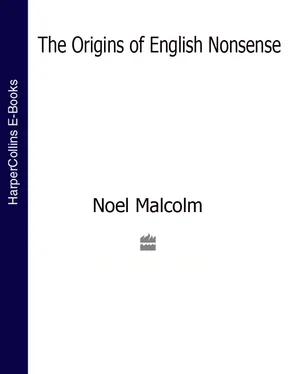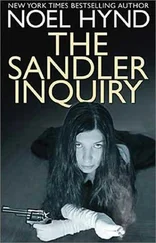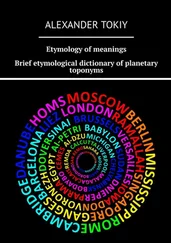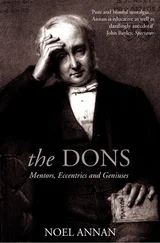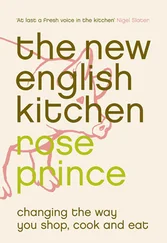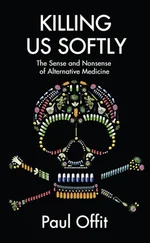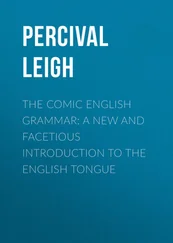The earliest French nonsense poetry which has come down to us was written in northern France (in Artois and the Île-de-France region) during the second half of the thirteenth century. Known as ‘fatrasies’, these early poems survive in two main collections, one by the poet Philippe de Rémi, sieur de Beaumanoir (1250–96), and the other, a group of poems called ‘Les Fatrasies d’Arras’, by an unknown writer (or writers). 20One example from the latter group will give the flavour of the genre:
Vache de pourcel,
Aingnel de veël,
Brebis de malart;
Dui lait home bel
Et dui sain mesel,
Dui saiges sotart,
Dui emfant nez d’un torel
Qui chantoient de Renart,
Seur la pointe d’un coutel
Portoient Chastel Gaillart. 21
Cow born of a pig,
Lamb born of a calf,
Sheep born of a duck;
Two ugly handsome men
And two healthy lepers,
Two wise idiots,
Two children born of a bull,
Who sang about Reynard,
Carried Château Gaillard
On the point of a knife.
The precise origins of this type of poetry are obscure. One modern scholar has tried to show that these poems were riddles with specific personal and political meanings. 22It is possible that they developed in connection with some kind of literary game, perhaps involving the parodying of gnomic or over-elaborate courtly poetry; this may have been the work of Philippe de Rémi, whose verses are probably earlier than those of the Arras collection. 23These French nonsense poems have a distinctive character: they lack the unifying narrative structure of the German poems, and their impossibilia are generally less visual or physical, less energetic and not so densely packed. But on the other hand the basic similarity with the German poems of the thirteenth century is inescapable. The very idea of putting together strings of impossibilia, not for their traditional rhetorical purpose but simply for the effect of comic absurdity which they produced on their own, is fundamental to both the German and the French poems, and it is very unlikely that this idea was just invented independently on two occasions, within the same century, in two neighbouring countries. 24Literary influences flowed to and fro between the French and German vernaculars throughout the Middle Ages (as the complex development of the Roman de Renart shows). The universities of northern France were frequented by large numbers of German students; one fourteenth-century German lament for the decay of Orléans University says that the sound of the German language was once so loud in the streets of Orléans that one would have thought oneself in the Fatherland. 25It is highly likely that an ingenious new style of poetry invented by German Minnesingers, even though it may have been a minor experimental genre known only through a few examples, should eventually have percolated into French poetic culture too.
As the genre developed in France during the fourteenth and fifteenth centuries (in a slightly different verse-form, known as the ‘fatras’), it was treated simply as a form of humorous poetry, and described also as a ‘frivole’ or ‘folie’. Not all of the ‘fatras’ were nonsense poems putting together impossible collocations of ideas; such versions of the ‘fatras’ died out in the early fifteenth century. 26Nonsense poetry thus enjoyed a much shorter continuous history in France than it did in Germany. But something of the spirit of the ‘fatras’ was revived in the sixteenth century by the poet Clément Marot, in a form of his own invention known as the ‘coq-à-l’âne’. 27
The French literary historian Paul Zumthor has made a useful distinction between ‘relative’ and ‘absolute’ nonsense poetry. 28In relative nonsense, each line or couplet makes sense in itself, and it is only the juxtaposition of them in the verse that is without meaning; whereas in absolute nonsense the transgressions of sense occur within the smallest units of the poetry. As the example given above makes clear, the ‘fatrasie’ was capable of thorough-going absolute nonsense. Other types of French medieval poetry exploited the techniques of relative nonsense: foremost among them was the ‘resverie’, which put together a pointless sequence of personal statements, sententious remarks or fragments of conversation. 29Each statement was a distich of unequal length, linked to the next by rhyme (ab, bc, cd, etc.): this strongly suggests that the form had its origin in a dialogue-game between two poets. Thus, for example:
Nul ne doit estre jolis
S’il n’a amie.
J’aime autant crouste que mie,
Quant j’ai fain.
Tien cel cheval par le frain,
Malheüreus! … 30
No-one should be happy
Without a girl he loves.
I like the crust as much as the dough,
When I’m hungry.
Take this horse by the bridle,
Miserable man! …
This kind of poem seems to have been, originally, a peculiarly French phenomenon. Its most ambitious development took place on the French stage, where the writers of comic drama during the fifteenth and sixteenth centuries delighted in stringing together such sequences of inconsequentialities, known as ‘menus propos’; one classic work, the Sottie des menus propos , consists quite simply of three speakers playing this game for a total of 571 lines. 31But this French nonsense genre in turn gave rise to similar types of nonsense in two other countries. One was Germany, where a form of inconsequential platitude poem known as the ‘quodlibet’ grew up in the fourteenth and fifteenth centuries. It consisted, as the classic modern study by Hanns Fischer puts it, of a succession of small units, containing general statements of the obvious and ironic pieces of moral instruction, ‘the comedy of which lies above all in the inconsequentiality with which they are put together’. 32Thus:
Nu hör wie gar ain tor ich bin
Ich trunck durch die wochen win
Für laster wiche wasser
Von baden wirt man nasser … 33
Now hear what an utter fool I am:
I drank wine for weeks;
In order to be vicious, avoid water.
Bathing makes you wetter …
The standard view, formulated by Fischer, is that the quodlibet was the overall genre, of which the Lügendichtung was a peculiar sub-species. (He therefore renamed the Lügendichtung the ‘Lügenquodlibet’.) However, the Lügendichtungen were more common than these platitude-quodlibets, of which only three instances are known. 34It makes more sense, surely, to suppose that these German platitude-poems reflected an importation into Germany of the French resverie. The fact that the French version has a slightly more complicated ab, bc, cd rhyme-scheme, while the German has the simpler aa, bb, cc form (in which each unit of sense usually occupies one couplet), strongly suggests that if there were any relation between the two, it was the German version which was an adaptation of the French, and not vice-versa.
The other country which seems to have been influenced by the resverie was Italy. Two types of relative nonsense developed in Italian poetry in the fourteenth century: the ‘motto confetto’ and the ‘frottola’. Both operated by stringing together inconsequential series of remarks, the former in elegantly sententious literary language, and the latter in a much more personal and colloquial style. 35The frottola never crossed the frontiers of absolute nonsense, but it did expand in its subject-matter into four large areas: the descriptive, the gnomic, the political, and the poem of personal confession. 36And it attracted the interest of major poets of the fourteenth century, such as Franco Sacchetti (c.1332–1400), who were exploring various kinds of ostentatiously anti-‘poetic’ poetry – ‘burlesque’ or ‘realist’ poetry which used colloquial language and described the real conditions of the poet’s often poverty-stricken life. 37
Читать дальше
